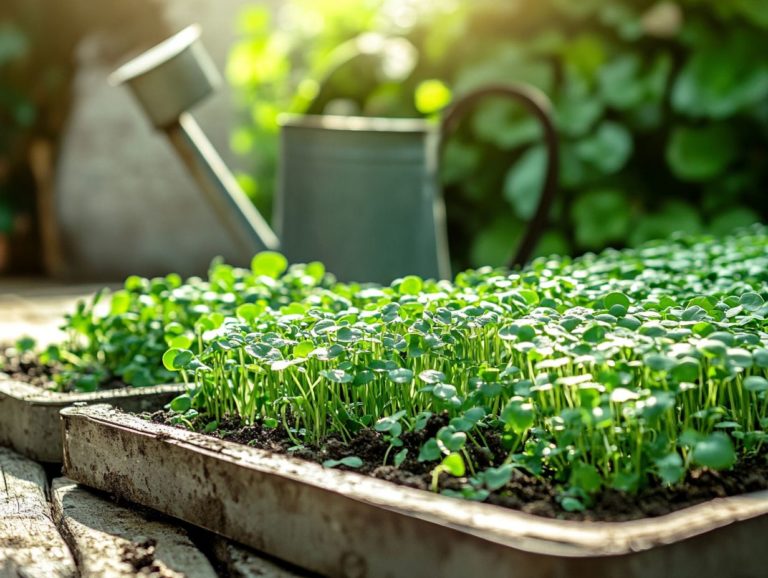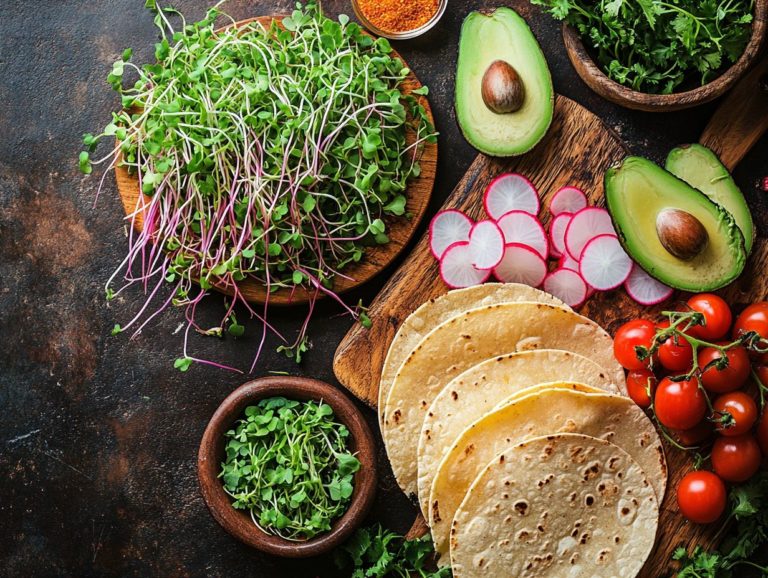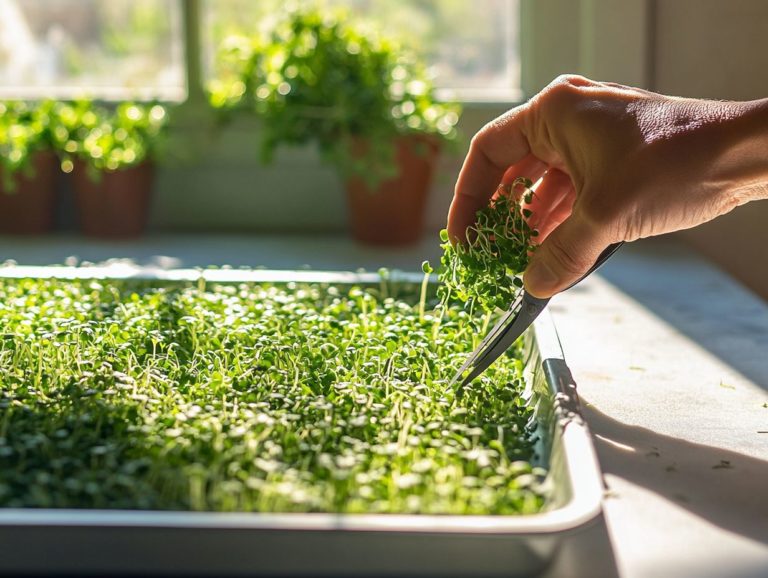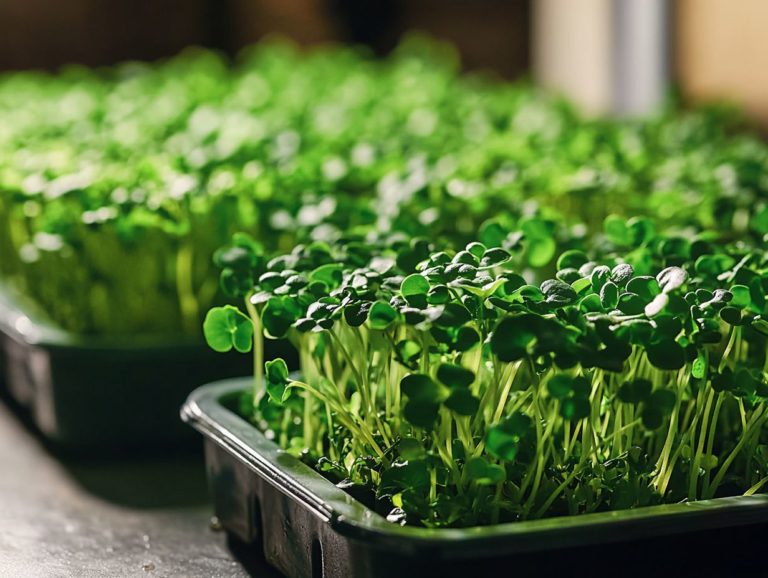What Are the Best Resources for Microgreen Growing?
Microgreens have revolutionized the culinary landscape. They offer an explosion of flavor and nutrition packed into a tiny bundle.
Thinking about growing your own microgreens? Understanding the right resources is crucial for your success.
This guide is your comprehensive companion. It covers everything from nutritional benefits to selecting the best seeds, soil, and tools.
With expert tips available, you’ll be ready to cultivate a flourishing microgreen garden at home. Whether you re a seasoned gardener or just starting out, this guide will make your microgreen journey both enjoyable and rewarding.
Contents
- Key Takeaways:
- Benefits of Growing Microgreens
- Choosing the Right Resources for Growing Microgreens
- Best Resources for Microgreen Growing
- Tips for Maximizing Your Microgreen Growing Experience
- Frequently Asked Questions
- What Are the Best Resources for Microgreen Growing?
- What are the benefits of using online resources for microgreen growing?
- Which websites are recommended for microgreen growing information?
- Are there any books specifically dedicated to microgreen growing?
- Can I trust information from experienced microgreen growers?
- Are there any in-person resources for microgreen growing?
Key Takeaways:

- Start with the basics: choose quality seeds and nutrient-rich soil.
- Connect with community: join online forums for valuable tips.
- Avoid common mistakes to maximize your growing experience and enjoy the benefits.
What are Microgreens?
Microgreens are your secret weapon in the culinary world. These young, edible plants are harvested just after germination and burst with vibrant flavors and colors.
They are packed with health-promoting nutrients, including vitamins and minerals. Varieties like broccoli sprouts, arugula, and sunflower are popular among home gardeners and chefs alike.
It’s easy to grow them indoors. This makes them perfect for small-space gardening on your kitchen windowsill.
The growth process is surprisingly simple. Typically, it takes just 7 to 21 days from seed to harvest, depending on the variety.
Consider options like radish, beet, and basil microgreens. Each offers unique flavors that can elevate your dishes.
These greens enhance both the visual appeal of your meals and provide a wealth of vitamins A, C, E, and K, along with essential minerals like iron and magnesium.
Incorporating these nutrient-dense plants into your meals is a delightful way to boost your health. They support everything from immune function to heart health.
Benefits of Growing Microgreens
Growing microgreens offers many benefits beyond their delightful flavors and striking appearance. They are quick to cultivate and space-efficient, making them ideal for indoor gardening.
These vibrant greens are a rich source of nutrients that contribute to a well-rounded diet and elevate your overall wellness.
Nutritional Benefits
Microgreens are celebrated as true nutritional powerhouses. They provide a concentrated source of vitamins, minerals, and antioxidants.
These tiny greens often contain higher concentrations of essential nutrients than their mature counterparts. For example, radish microgreens can offer up to six times more vitamin C than fully grown radishes, supporting collagen production and skin health.
Similarly, broccoli microgreens are renowned for their high levels of sulforaphane. This compound is linked to cancer prevention and surpasses the nutrient content of adult broccoli.
Incorporating these vibrant greens into your meals can lead to improved heart health, strengthened immunity, and better digestion. Enjoy a delightful burst of flavor and freshness!
Environmental Benefits
Growing microgreens is not just about nourishing your body; it s an impactful choice for the environment, making it a sustainable option for you as a home gardener and an eco-conscious consumer.
These petite greens can thrive in small spaces, drastically reducing the need for large farms and minimizing the carbon footprint linked to transporting fresh produce.
Beyond their modest resource needs, you can easily grow vibrant microgreens right in your home or garden with minimal water and soil. This allows you to join this green movement no matter your living situation.
The waste generated from these tiny crops can be easily composted, enriching the soil for your future gardening endeavors.
By growing your own food, you not only help reduce reliance on large farms but also embrace environmental stewardship. This seemingly simple act of home gardening can spark a heightened awareness of sustainable practices, encouraging a healthier lifestyle and ultimately deepening your connection with nature.
Choosing the Right Resources for Growing Microgreens
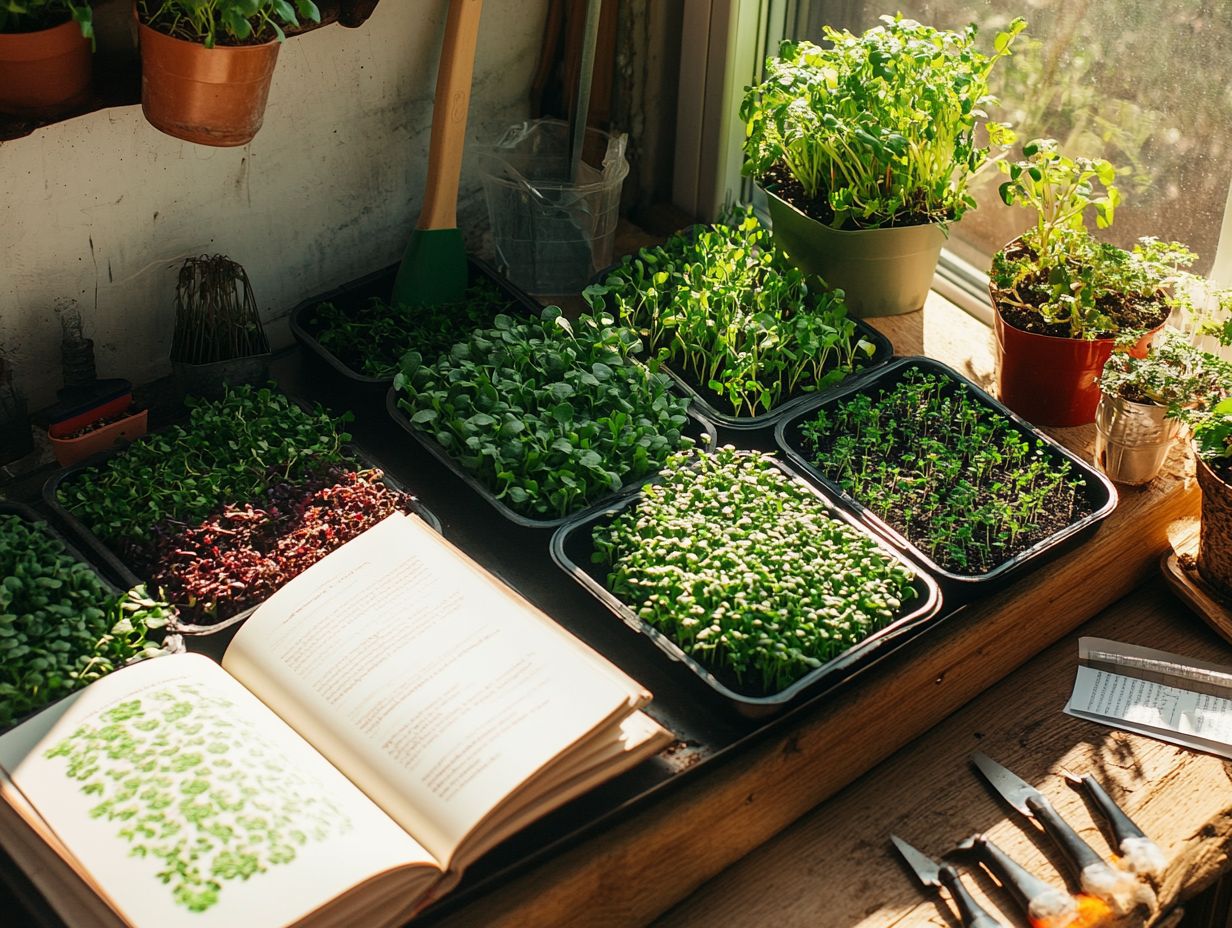
Choosing the right resources is essential for achieving successful growing microgreens, as it significantly impacts the quality and yield of your nutrient-rich greens.
By selecting the finest microgreen seeds and the most suitable growing medium, you can enhance your home gardening experience. Additionally, knowing what containers you can use for microgreens will empower you to optimize your efforts and secure a bountiful harvest.
Types of Resources Available
When you embark on your microgreens growing journey, a wealth of resources awaits to support your efforts, including measuring cups and suggested watering techniques, ensuring you have everything necessary for successful cultivation.
Key resources include high-quality seeds specifically for microgreens, suitable growing mediums like organic potting soil, and specialized microgreens kits tailored for both beginners and seasoned gardeners.
In addition to these essentials, various tools such as seed trays, humidity covers (which help maintain the ideal environment for growing), and LED grow lights can significantly enhance your growing experience.
Many gardeners gravitate towards trusted brands like Burpee or High Mowing Organic Seeds, known for their reliable germination rates and vibrant crops.
Exploring an array of seeds, from radish to sunflower, can add delightful diversity to your harvest, while selecting a well-draining, organic mix as a growing medium fosters healthy development. By becoming familiar with these resources, you can cultivate the perfect environment for your microgreens to flourish.
Factors to Consider
Consider several critical factors to ensure optimal growth conditions for your microgreens, as they influence everything from the process of seeds starting to grow to harvest.
Proper watering techniques, adequate sunlight exposure, and precise seed measurements are essential, as these elements can greatly affect the success of your production.
To achieve the best results, pay close attention to the quality of your growing medium; it plays a vital role in nutrient retention and drainage. Utilizing a seed-starting mix or a hydroponic medium specifically designed for microgreens can significantly enhance growth. For the best options, check out what seeds can I use for microgreens.
Maintaining a consistent temperature between 65 F and 75 F fosters an ideal environment for germination. Regularly monitoring humidity levels helps prevent mold, while ensuring proper air circulation safeguards against diseases.
By implementing these practices and adapting them to your unique growing conditions, you’ll be well on your way to a bountiful microgreen harvest.
Best Resources for Microgreen Growing
Identifying the finest resources for growing microgreens will undoubtedly elevate your gardening experience, granting you access to top-quality seeds, essential tools, and a supportive community.
From carefully selecting the best microgreen seeds to employing recommended tools such as growing trays, every resource plays a crucial role in achieving a bountiful microgreens harvest.
Start your microgreen journey today!
Top Picks for Seeds and Soil
Choosing the best seeds and soil is essential for growing microgreens successfully. The quality you choose affects both growth and nutrient density.
Try vibrant seeds like arugula and broccoli sprouts. They offer exceptional flavor and health benefits.
Your choice of soil is just as important. A well-draining, nutrient-rich blend fosters robust development.
Before planting, it’s wise to moisten the soil with organic potting soil to ensure it s evenly damp but not soggy. This preparation creates the perfect environment for the seed germination process and supports healthy plants.
Recommended Tools and Equipment
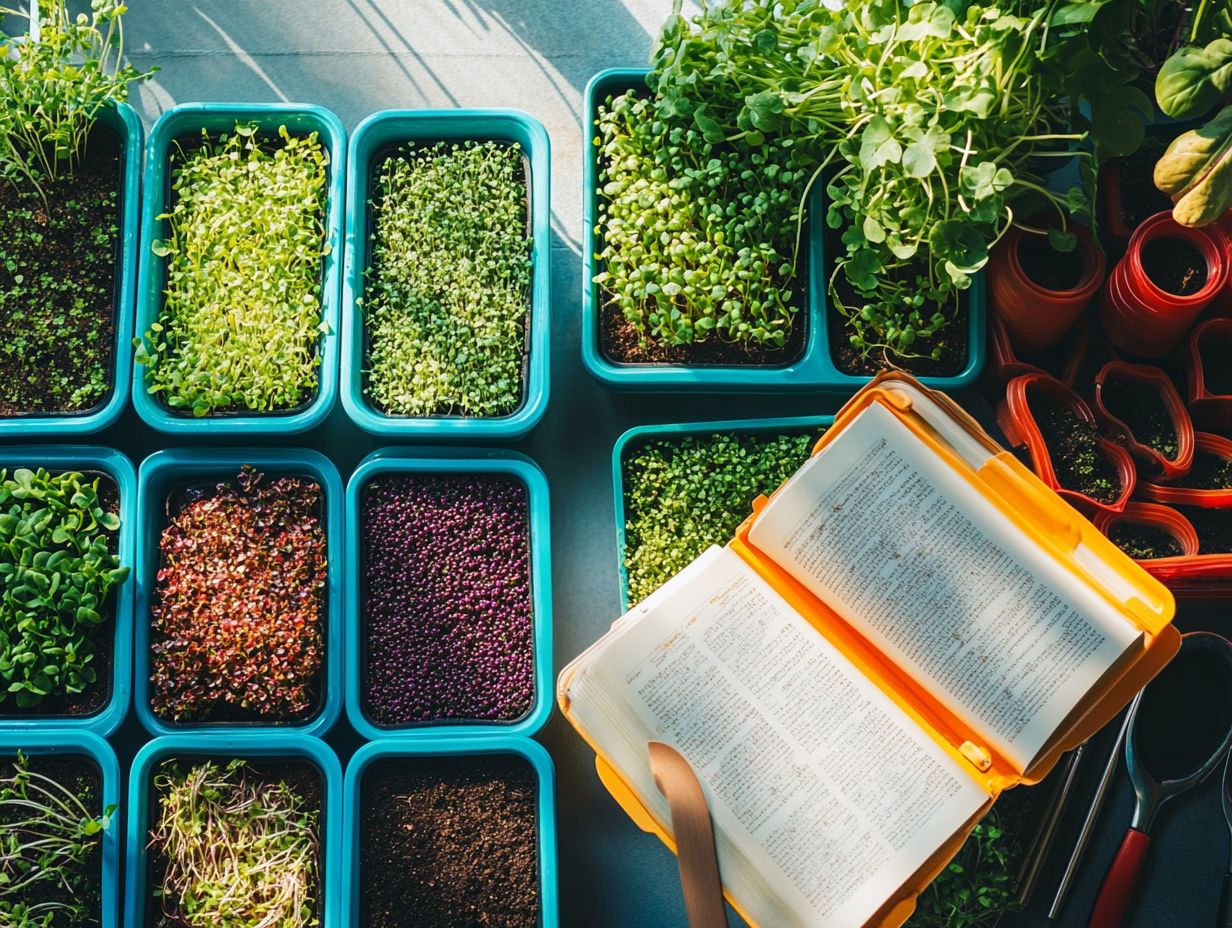
Having the right tools can change how you grow microgreens at home. This boosts both efficiency and success.
- Microgreens kit and measuring cups
- Measuring cups for precise seed portions
- Growing trays designed to optimize space and sunlight exposure for your indoor plants
Investing in high-quality soil or growing medium is crucial, as it ensures your microgreens receive the nutrients they need.
A spray bottle for watering microgreens helps maintain moisture without over-saturating the soil. Additionally, a pair of sharp scissors for precise microgreens harvest allows you to harvest at just the right moment.
If you’re passionate about indoor gardening, LED grow lights can effectively simulate natural sunlight, promoting robust growth even in less-than-ideal lighting conditions.
Local garden centers and online platforms like Amazon provide easy access to these essential tools, making it simpler than ever to start your journey of microgreen cultivation.
Helpful Online Communities and Forums
Joining online communities can greatly improve your gardening experience. You’ll gain valuable insights and support from fellow enthusiasts.
These platforms are treasure troves of information, tips, and shared experiences related to home gardening, making them excellent resources for both novice and seasoned growers.
By participating, you enrich your own gardening journey while fostering collaboration within home gardening communities. Many gardeners discover camaraderie as they discuss their successes and challenges, leading to innovative growing techniques.
Popular forums such as Reddit s r/microgreens and various gardening groups on Facebook serve as fantastic starting points. Platforms like GardenWeb and GrowVeg allow you to connect with like-minded individuals who share your passion.
By sharing your experiences and advice in these spaces, you cultivate not just plants, but also a thriving community of passionate microgreens enthusiasts.
Tips for Maximizing Your Microgreen Growing Experience
To elevate your microgreen growing experience, adopt these key strategies for microgreen growth that can profoundly enhance your success and efficiency.
By recognizing the common pitfalls that beginners often encounter, along with valuable insights from experts, you ll be empowered to cultivate nutrient-rich greens with both ease and confidence.
Common Mistakes to Avoid
Avoiding common mistakes while growing microgreens can save you both time and resources, ensuring a successful harvest of vibrant, healthy greens. Key pitfalls to watch out for include:
- Improper watering techniques
- Neglecting to pre-soak seeds before planting
- Failing to provide adequate growing conditions for various microgreens
all of which can dramatically impact microgreen growth and yield.
For example, a first-time grower learned this lesson the hard way: after losing an entire batch to soggy soil, they switched to using a spray bottle for gentle, controlled moisture, and their microgreens thrived.
Failing to soak seeds especially varieties like peas and sunflowers can lead to dismal germination rates. A simple fix? Soak those seeds for 4 to 8 hours before planting.
Inadequate lighting is another issue that can stunt growth. By utilizing grow lights, you can significantly improve both yield and quality. It’s clear that small adjustments can lead to flourishing microgreens at home.
Expert Tips for Success
Incorporating expert tips into your microgreen growing routine can lead to remarkable improvements in both production and quality, allowing you to fully appreciate the benefits of these nutrient-rich plants. From optimizing your environment for growing to mastering the best watering techniques, these insights can truly elevate your indoor gardening experience.
To maximize the potential of your microgreens, paying close attention to light exposure is essential. Ideally, these plants flourish under fluorescent or LED grow lights that strike a perfect balance between blue and red spectrum light, effectively mimicking natural sunlight. Additionally, understanding what soil is best for microgreens can further enhance their growth.
Employing a meticulous watering technique will help prevent mold growth and promote healthy roots. Consider using a spray bottle to provide gentle moisture without the risk of oversaturation.
Pest control is another vital component; integrating natural deterrents to pests such as neem oil can effectively combat harmful insects while preserving the organic integrity of your greens.
Embrace these strategies and watch your microgreens thrive like never before!
Frequently Asked Questions
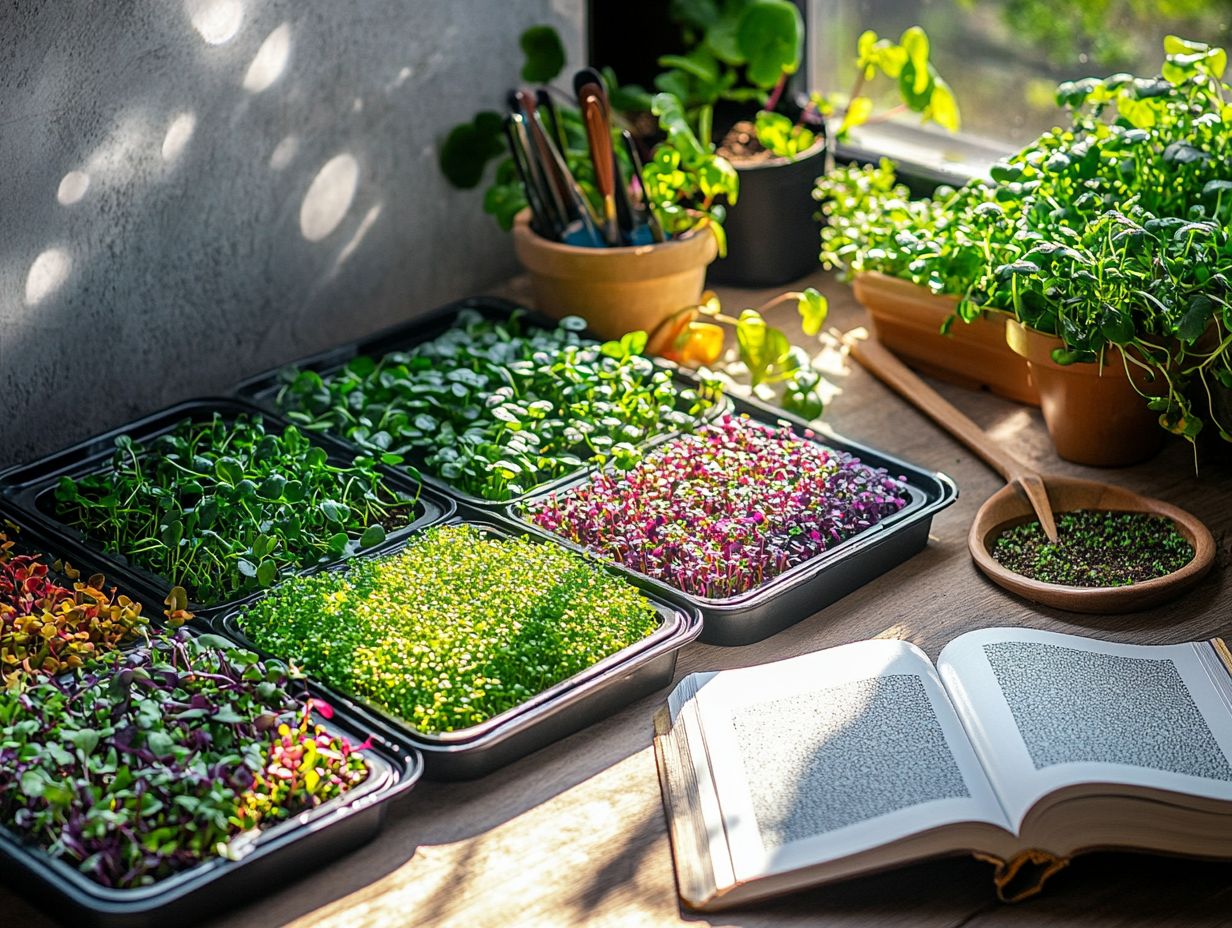
What Are the Best Resources for Microgreen Growing?
The best resources for microgreen growing are those that provide comprehensive and reliable information on all aspects of the process. Some examples include reputable websites, books, and experienced growers.
What are the benefits of using online resources for microgreen growing?
Using online resources for microgreen growing can provide a wide range of benefits. These include convenience, access to a larger pool of information, and the ability to connect with other growers for tips and advice.
Which websites are recommended for microgreen growing information?
There are several reputable websites that provide valuable information on microgreen growing, such as Microgreens Farmer, Grow Your Microgreens, and MIgardener. These sites offer detailed guides, tips, and techniques for successful microgreen cultivation.
Are there any books specifically dedicated to microgreen growing?
Yes, there are many books available that focus solely on microgreen growing. Some popular titles include “Microgreens: A Guide to Growing Nutrient-Packed Greens” by Eric Franks and Jasmine Richardson, and “The Complete Microgreens Cookbook: Everything You Need to Know to Grow and Eat Microgreens” by Karin Eliason, David Silverman, and Vicki L. Poellnitz.
Can I trust information from experienced microgreen growers?
You can absolutely trust information from experienced microgreen growers. They have real-life experience and can share useful tips based on their successes and failures.
Are there any in-person resources for microgreen growing?
Yes, you can find various in-person resources like workshops and classes! These opportunities provide hands-on learning and let you ask questions directly to experts.


